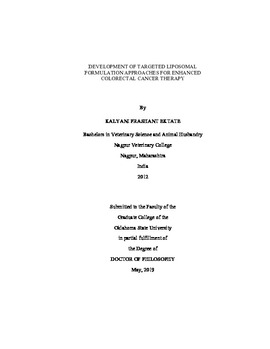| dc.contributor.advisor | Ranjan, Ashish | |
| dc.contributor.author | Ektate, Kalyani Prashant | |
| dc.date.accessioned | 2020-01-30T15:03:04Z | |
| dc.date.available | 2020-01-30T15:03:04Z | |
| dc.date.issued | 2019-05 | |
| dc.identifier.uri | https://hdl.handle.net/11244/323342 | |
| dc.description.abstract | Colorectal cancer (CRC) is the 4th most commonly detected cancer in the USA. Despite promising advances, the 5-year survival rate for the metastatic disease remains dismal (<15%) due to the presence of chemo-resistant and immune-suppressive tumor microenvironment. In addition, CRC outcomes can suffer from a lack of real-time treatment monitoring, preventing rapid treatment interventions. To overcome these barriers, we hypothesized that, modifying low temperature sensitive liposomes (LTSLs) that release the encapsulated doxorubicin at >40⁰C with ultrasound contrast agents and bacterial attachments can improve the real-time chemo-immunotherapy of CRC. Towards these goals, we investigated the following specific aims in murine models of colon cancer: 1) Develop echogenic-LTSL (E-LTSL) for real-time ultrasound-enhanced reporting of tumor temperature and doxorubicin delivery, 2) Utilize tumor homing Salmonella typhimurium for LTSL delivery and enhanced chemo-immunotherapy with High Intensity Focused Ultrasound (HIFU) tumor heating (~42°C), and 3) Investigate the ability of magnetic bacteria Magnetospirillim magneticum (AMB-1) to aid LTSL tumor drug delivery under magnetic guidance. Our data showed that intratumoral vascular contrast of E-LTSL as a function of temperature and doxorubicin delivery was strongly correlated, enabling robust estimation of temporal variation in colon tumor temperature and drug delivery. LTSL attachment didn’t impact Salmonella viability and improved chemo-immunotherapy outcomes in murine colon cancers by promoting the population of M1 macrophages with HIFU heating. Finally, the use of magnetic guidance for AMB-LTSL significantly reduced the colon cancer viability by enhancing cellular and tumor localizations of doxorubicin. In conclusion, we found that multifunctional LTSL formulations significantly improved the CRC treatment outcomes in murine models by aiding the real-time monitoring and removing the resistive and suppressive tumor microenvironment features. | |
| dc.format | application/pdf | |
| dc.language | en_US | |
| dc.rights | Copyright is held by the author who has granted the Oklahoma State University Library the non-exclusive right to share this material in its institutional repository. Contact Digital Library Services at lib-dls@okstate.edu or 405-744-9161 for the permission policy on the use, reproduction or distribution of this material. | |
| dc.title | Development of Targeted Liposomal Formulation Approaches for Enhanced Colorectal Cancer Therapy | |
| dc.contributor.committeeMember | Malayer, Jerry | |
| dc.contributor.committeeMember | Bailey, Keith | |
| dc.contributor.committeeMember | Piao, Daqing | |
| osu.filename | Ektate_okstate_0664D_16298.pdf | |
| osu.accesstype | Open Access | |
| dc.type.genre | Dissertation | |
| dc.type.material | Text | |
| dc.subject.keywords | cancer | |
| dc.subject.keywords | drug delivery | |
| dc.subject.keywords | high intensity focused ultrasound | |
| dc.subject.keywords | liposomes | |
| dc.subject.keywords | magnetospirillum magneticum | |
| dc.subject.keywords | salmonella typhimurium | |
| thesis.degree.discipline | Veterinary Biomedical Science | |
| thesis.degree.grantor | Oklahoma State University | |
